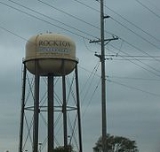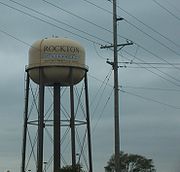
Rockton, Illinois
Encyclopedia

Winnebago County, Illinois
Winnebago County is a county located in the U.S. state of Illinois. According to the 2010 census, it has a population of 295,266, which is an increase of 6.1% from 278,418 in 2000...
, Illinois
Illinois
Illinois is the fifth-most populous state of the United States of America, and is often noted for being a microcosm of the entire country. With Chicago in the northeast, small industrial cities and great agricultural productivity in central and northern Illinois, and natural resources like coal,...
, United States
United States
The United States of America is a federal constitutional republic comprising fifty states and a federal district...
located on the banks of the Rock River
Rock River (Illinois)
The Rock River is a tributary of the Mississippi River, approximately long, in the U.S. states of Wisconsin and Illinois. It rises in southeast Wisconsin, in the Theresa Marsh near Theresa, Wisconsin in northeast Dodge County, Wisconsin approximately south of Fond du Lac, Wisconsin...
. It is part of the Rockford, Illinois
Rockford, Illinois
Rockford is a mid-sized city located on both banks of the Rock River in far northern Illinois. Often referred to as "The Forest City", Rockford is the county seat of Winnebago County, Illinois, USA. As reported in the 2010 U.S. census, the city was home to 152,871 people, the third most populated...
Metropolitan Statistical Area
Rockford metropolitan area
The Rockford Metropolitan Statistical Area, as defined by the United States Census Bureau, is an area consisting of two counties in north-central Illinois, anchored by the city of Rockford. As of the 2000 census, the MSA had a population of 320,204...
. The population was 7,685 at the 2010 census, up from 5,296 at the 2000 census.
Geography
Rockton is located at 42°27′3"N 89°3′50"W (42.450753, -89.063844).According to the United States Census Bureau
United States Census Bureau
The United States Census Bureau is the government agency that is responsible for the United States Census. It also gathers other national demographic and economic data...
, the village has a total area of 3.7 square miles (9.6 km²), of which, 3.5 square miles (9.1 km²) of it is land and 0.2 square mile (0.517997622 km²) of it (4.86%) is water.
History
Native American tribes originally inhabited the area. Stephen Mack, Jr.Stephen Mack, Jr.
Stephen Mack, Jr.. adventurer and pioneer, American Fur Company employee, founder of Rockton, Illinois.-Background and early life 1798-1819:...
, who married the Native American princess named Hononegah
Hononegah
Hononegah was the wife of Stephen Mack, Jr. an employee for The American Fur Company, a pioneer to the Rock River Valley in northern Illinois and founder of the community of Rockton, Illinois...
, is considered the founder of the Rockton area. His original outpost (c. 1830s) became part of an area called Macktown. He was the first white settler in the area. Citizens lived in Macktown and would commute to Rockton over the Rock River. In the winter of 1846 an ice jam damaged the bridge to Rockton. The bridge was built with funding from Stephen Mack. However, he did not re-build it, which led citizens to permanently move to Rockton.
Hononegah, Steven Mack's wife, was so well-liked by the people of Winnebago County that virtually the entire county was in attendance at her funeral. The homestead is still standing and is open to the public along with other buildings from the period.
Demographics
As of the censusCensus
A census is the procedure of systematically acquiring and recording information about the members of a given population. It is a regularly occurring and official count of a particular population. The term is used mostly in connection with national population and housing censuses; other common...
of 2006, there were 7,440 people, 1,930 households, and 1,464 families residing in the village. The population density
Population density
Population density is a measurement of population per unit area or unit volume. It is frequently applied to living organisms, and particularly to humans...
was 1,505.5 people per square mile (580.9/km²). There were 2,008 housing units at an average density of 570.8 per square mile (220.3/km²). The racial makeup of the village was 97.47% White, 0.70% African American, 0.08% Native American, 0.81% Asian, 0.04% Pacific Islander, 0.45% from other races
Race (United States Census)
Race and ethnicity in the United States Census, as defined by the Federal Office of Management and Budget and the United States Census Bureau, are self-identification data items in which residents choose the race or races with which they most closely identify, and indicate whether or not they are...
, and 0.45% from two or more races. Hispanic or Latino of any race were 1.53% of the population.
There were 1,930 households out of which 42.3% had children under the age of 18 living with them, 65.2% were married couples
Marriage
Marriage is a social union or legal contract between people that creates kinship. It is an institution in which interpersonal relationships, usually intimate and sexual, are acknowledged in a variety of ways, depending on the culture or subculture in which it is found...
living together, 8.4% had a female householder with no husband present, and 24.1% were non-families. 20.6% of all households were made up of individuals and 8.5% had someone living alone who was 65 years of age or older. The average household size was 2.72 and the average family size was 3.18.
In the village the population was spread out with 31.1% under the age of 18, 6.2% from 18 to 24, 31.4% from 25 to 44, 21.5% from 45 to 64, and 9.8% who were 65 years of age or older. The median age was 35 years. For every 100 females there were 97.6 males. For every 100 females age 18 and over, there were 93.0 males.
The median income for a household in the village was $57,292, and the median income for a family was $62,863. Males had a median income of $47,321 versus $32,771 for females. The per capita income
Per capita income
Per capita income or income per person is a measure of mean income within an economic aggregate, such as a country or city. It is calculated by taking a measure of all sources of income in the aggregate and dividing it by the total population...
for the village was $24,078. About 1.4% of families and 1.3% of the population were below the poverty line, including 1.3% of those under age 18 and none of those age 65 or over.

